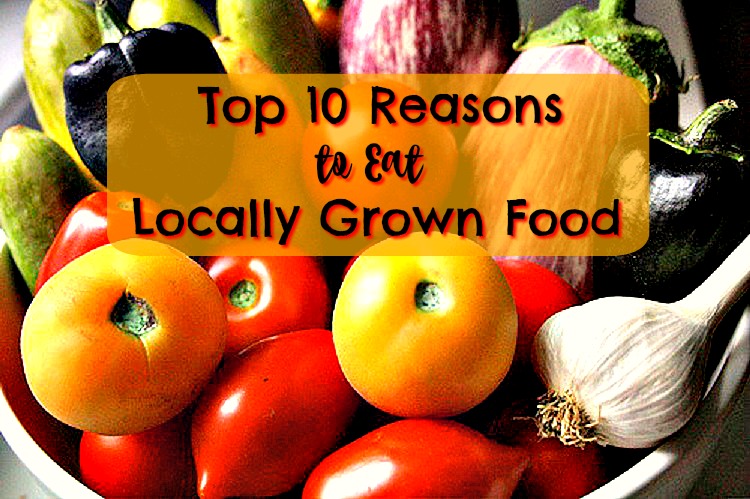
About 10 years ago, consumer preferences slowly started shifting away from conventionally produced foods to locally grown. The 2007 release of Michael Pollan’s book, The Omnivore’s Dilemma, was largely responsible for this change. Once awakened to the consequences of our food choices, many of us became much more conscious about what we were eating, how it was made, where it came from, and how it got on our plates. That book heightened awareness about our dependence on agribusiness and the moral and ecological consequences of our food choices.
Today, consumer demand for locally grown food is greater than ever. More and more, Americans are starting to understand that locally grown food is healthier, and that it benefits our local farmers and communities.
Let’s take a look at the top 10 reasons to eat locally grown food.
#1 It’s fresher.
Fresher food tastes better. And produce picked at its peak of freshness is far more nutritious than food that was picked days or weeks ago.
Commercial produce is often harvested before it is fully ripened. Then it has to be washed, packaged, placed on trucks or planes, warehoused and then, finally, transported to the supermarket. By the time it gets to our table, the nutrients have degraded. A lot.
#2 You support local farmers.
Sadly, most small farmers are struggling financially, and many have to take second jobs just to make ends meet. Buying food locally helps farmers earn income and creates local jobs for farm laborers.
#3 It’s safer.
When you buy food directly from your farmer or at a farmer’s market, you get to know your farmer personally. You know where your food came from, and how it was grown. You can ask what kind of practices were used. Plus, when the trip from farm to table is short, food is less likely to become contaminated.
#4 It’s seasonal.
Different crops grow during different times of the year. And many crops only grow in certain climates. Strawberries don’t grow in January, and you can’t grow pineapples in Maine. By eating food when it’s “in season” locally, we live more in rhythm with nature. If you eat a food when it’s growing and being harvested in your area, it will be fresher, tastier, more nutritious, and less expensive.
Also, when we eat by the seasons, we get to enjoy a wider variety of foods during the year. At farmer’s markets, we often find novel foods we’ve never tried before, or foods we wouldn’t ordinarily buy. But, because those foods are fresh and locally grown, we might become intrigued and decide to try them.
#5 It reduces waste.
Commercial processing, warehousing, and distribution of food results in significant waste because it takes a long time for food to get to market. Food rots in transit and has to be thrown away. When buying local, the trip from farm to table is short, leaving little opportunity for food to spoil.
#6 It builds up the soil.
Local farmers take great care of the land and work hard to supplement and enrich the soil using natural methods. Unlike Big Agro, they don’t poison us with pesticides and chemical fertilizers. Local farming also encourages diversification of crops. A single crop grown over a wide area will often deplete the soil.
#7 It’s good for our community.
Local foods enable consumers and farmers to connect on a personal level. And local farmer’s markets are fun places to meet, make new friends, and get to know your neighbors better.
#8 It supports our local economy.
The money you spend on locally grown food stays close to home. Farmers and growers reinvest revenue in local businesses, and use your money to pay service providers in your community. Local farmers and farmer’s markets also attract tourists who are especially interested in local artisan foods, like cheeses, wines, and olive oil. Tourists also enjoy kid-friendly farms and You-Pick-Farms that allow visitors to pick their own produce.
#9 It’s good for the environment.
Much local food is organic or transitionally grown, so the soil doesn’t become contaminated with chemicals that then leech into our water supply. And because locally grown food travels short distances, it requires far less fuel to transport and cuts way down on the production of greenhouse gases.
#10 It protects our land.
All over the United States, family farms have been rapidly disappearing. Farming involves hard work, and it won’t make you rich. Consequently, it’s rarely attractive to adult children who inherit the family farm when their parents pass away. This trend in selling off family farms has made it easy for developers to scoop up rich farmland, subdivide it, and build large communities of tract homes.
Buying locally grown food helps these small local farms survive and thrive, and makes farming more attractive to the next generation. Saving farms helps preserve our country’s open spaces, which have been dwindling rapidly as suburban sprawl grows.
We need our local farmers to thrive instead of hobbling along, barely breaking even. So please, make an effort to support the local farmers, farmer’s markets, and food artisans in your community. Eat at restaurants that serve food that’s been grown locally. Help educate others about the benefits of locally grown food by sharing this information with your friends. Post relevant articles on social media to raise awareness.
You can visit Local Harvest to find farms, farmer’s markets, restaurants, and other places in your community that offer locally grown food. Another good resource is Eat Local Grown — a crowd-sourced project that maintains a directory of local food businesses in your community.
